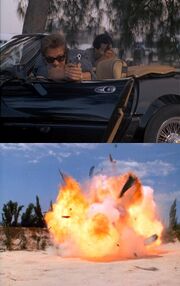Several extremely obvious Continuity Goofs occurred during Miami Vice's original network run, brought about not by oversights in the production of individual episodes but as a result of the studio tampering with the order in which those episodes were broadcast. The modification of the order of a television programme's season by the studio was a fairly common practice, particularly prior to the 1990s. It usually resulted from a desire to have more striking, hard-hitting or simply better quality episodes shown at specific points in a show's season (typically at the opening of the new season, during November and February "sweeps" - when ad rates are set for the remainder of the season - and towards the end of the season, also called "May Sweeps"). However, as many television series from the 1980s and earlier contained little in the way of overreaching plots that crossed multiple episodes, studios often made these changes with little research as to their consequences.
Their often brazen alterations to the broadcast schedule meant several notable continuity errors appeared in Miami Vice, many of them painfully obvious to anyone watching the show in the supposedly "correct" broadcast order.
Examples in Miami Vice
Some of the more notable studio-created continuity goofs include:
- Zito's beard, which he grows at the start of Season 2, continually appears and disappears between episodes for more than half of the season, indicating "The Dutch Oven", "Back in the World", "Definitely Miami" and "Yankee Dollar" were all broadcast earlier than intended. The reasons behind this are not known, although "The Dutch Oven" was originally filmed as part of Season 1, but later held back for the second season.

Crockett & Tubbs take cover behind the Daytona in "El Viejo" (top) despite the fact it was destroyed six episodes earlier! (bottom)
- The most famous continuity goof of the series occurs in Season 3's "El Viejo", when Crockett's Ferrari Daytona reappears without explanation, despite being blown to pieces in the season premiere, "When Irish Eyes Are Crying". The car is resurrected because the studio moved "El Viejo", which was originally going to be the season opener, back through the schedule, feeling the Daytona being blown up made a better start to the season. Apparently Don Johnson's holdout at the start of the third season, coupled with other commitments for guest star Willie Nelson, also meant that the episode could not be finished in time for the premiere slot, and so it was moved to later in the season so that the scenes featuring the two actors could be filmed.
- Also in Season 3, the title for the episode "Killshot" appears in the middle of the screen instead of at the bottom as in all the other episodes from the first part of the season. While not exactly a goof, this could be a sign that "Killshot" was originally supposed to air after "Forgive Us Our Debts", from which point episode titles were moved to the middle of the screen permanently.
- Tubbs, who grew a beard for the start of Season 4, is clean shaven in Season 5's "Bad Timing". However, his beard then reappears in the following episode, "Borrasca", only for him to shave it off during that episode. Even more ridiculously, Switek actually comments on how he looks better now that he has shaved in their next scene together. This change was probably made to accelerate the conclusion to the Sonny Burnett arc, which ends with Crockett's exoneration in "Bad Timing". However, Crockett's absence in "Borrasca" is heavily implied to be because he is away testifying to clear his name after his actions as Burnett, which also makes no sense when "Bad Timing" is shown first.
- The use of the same footage of Switek placing a bet from a payphone in both "Freefall" and "Too Much, Too Late" could also be seen as a studio-created continuity error, as the two appearances are supposedly separated by a significant amount of time (therefore removing the possibility that it's simply the same event viewed twice). The reason for the repetition was NBC's refusal to air the "lost" episode "Too Much, Too Late" due to its child molestation subject, which they deemed inappropriate for broadcast. However, Switek's actions in the episode are integral in setting up a plot point in the series finale, "Freefall", and as a result some of the footage was hastily re-integrated there.
Notes
- Another notable continuity goof is the reappearance of Crockett's Chris Craft Stinger powerboat in some shots in "Baseballs of Death". However, this is not a continuity goof created by studio tampering, but rather as a result of the inclusion of unused footage shot, presumably, when the Stinger was still in use on the show during Season 1. A reduced budget in later seasons could be responsible, or problems on set may have meant new material could not be filmed.
- While Miami Vice's cross-episode continuity was often affected by studio tampering, producer Michael Mann's other 1980s television series, Crime Story, had no such problems, largely because NBC executives were made aware from the start that it featured a single plot arc that stretched across it's entire production, necessitating a fixed broadcast order. This arc-driven style is commonplace today, with shows such as 24, The Sopranos, The Wire and the re-imagined Battlestar Galactica all featuring stories that reach across multiple episodes and even multiple seasons. Crime Story is often cited as the prototype for this concept.